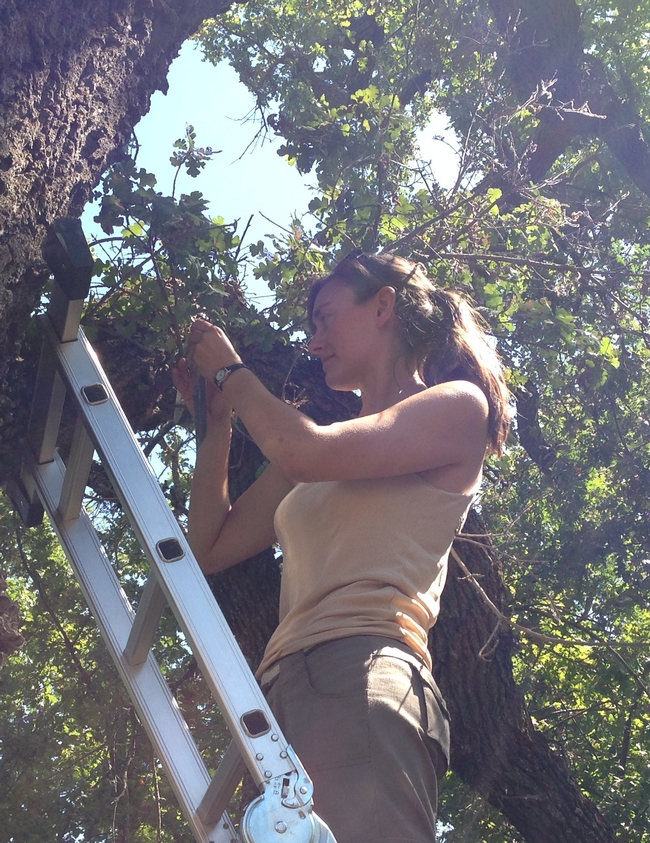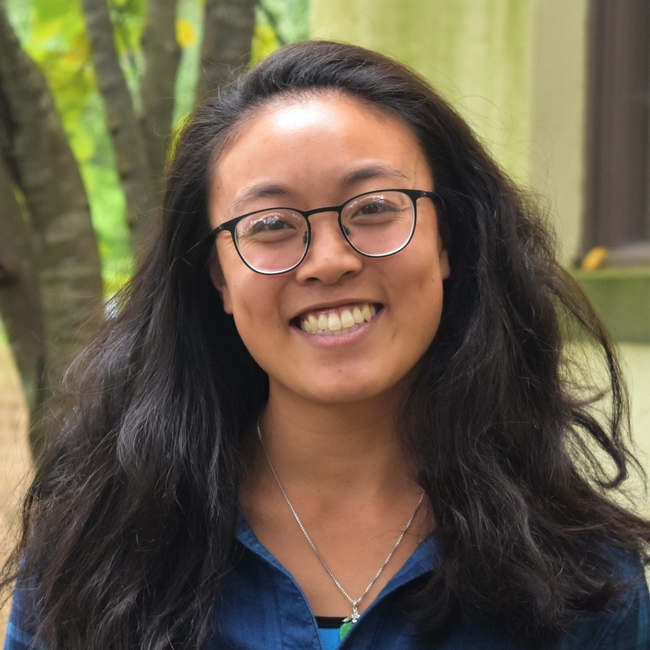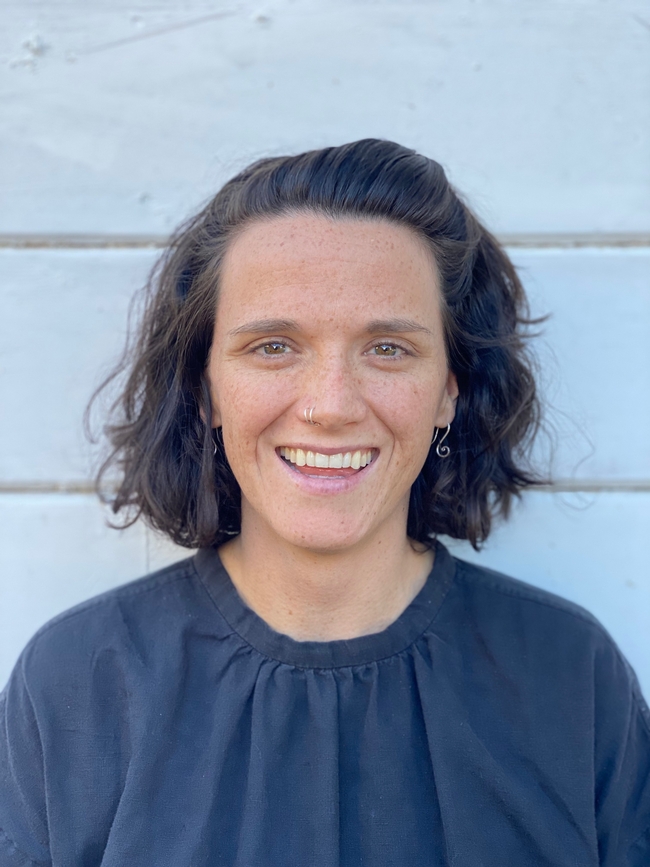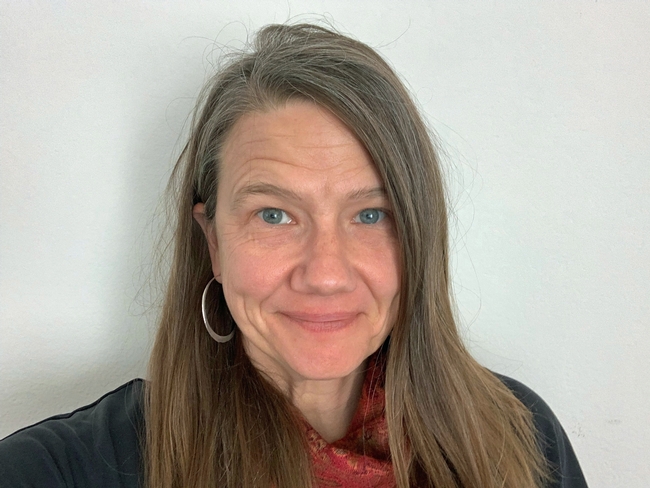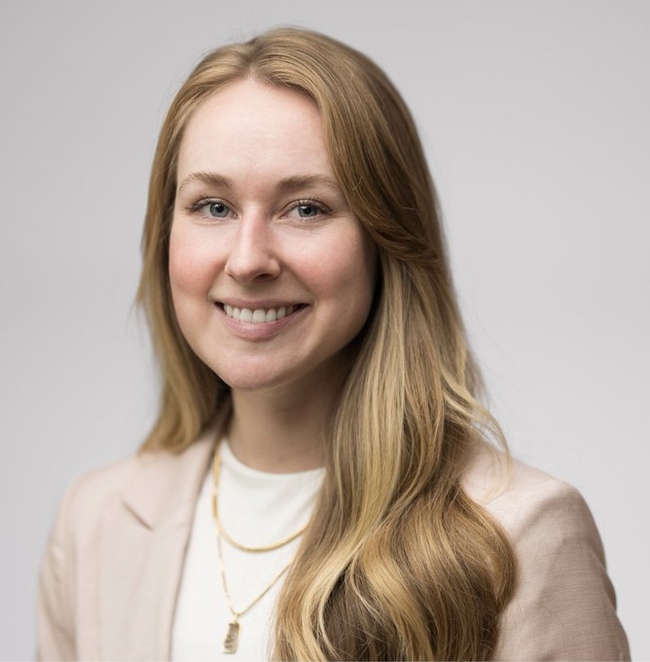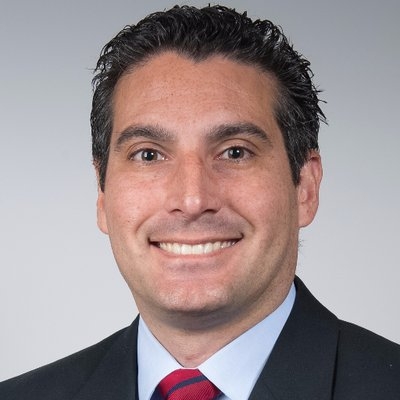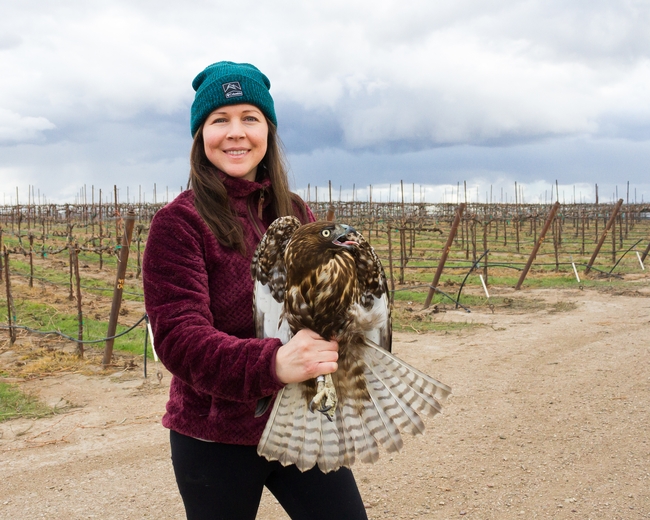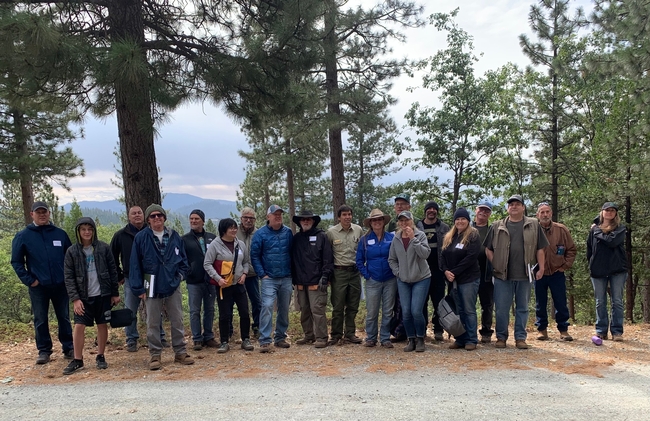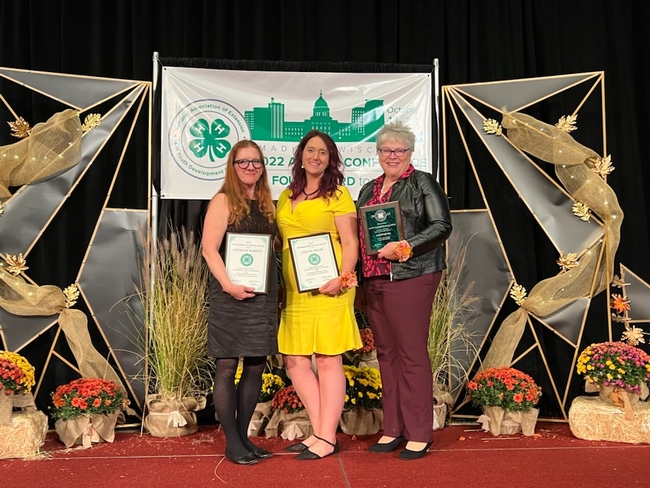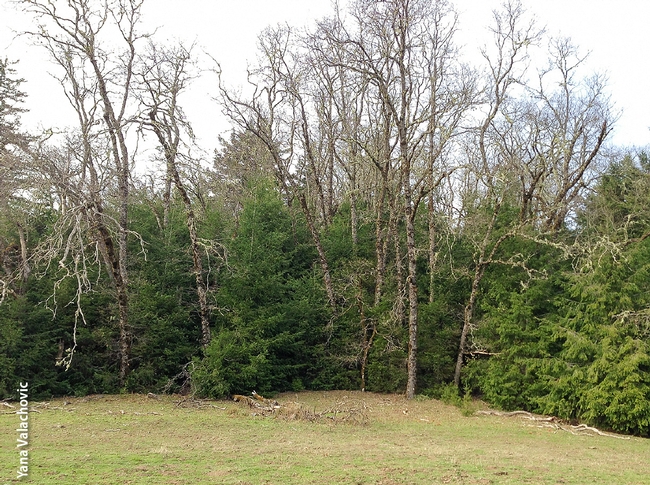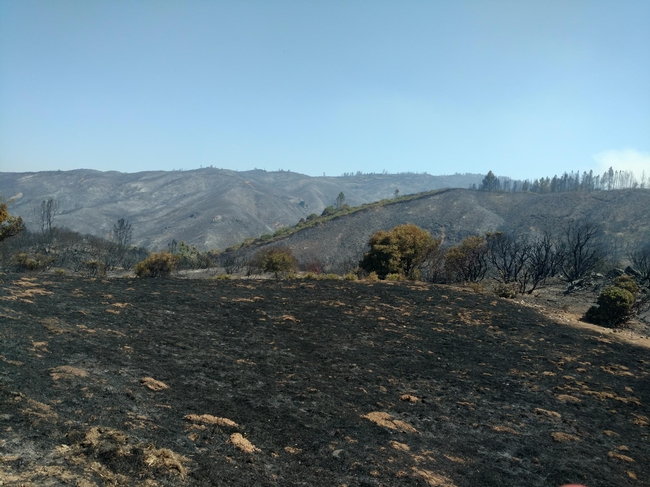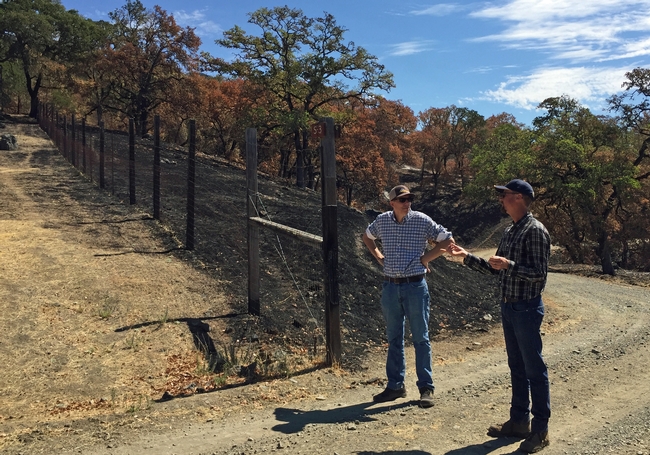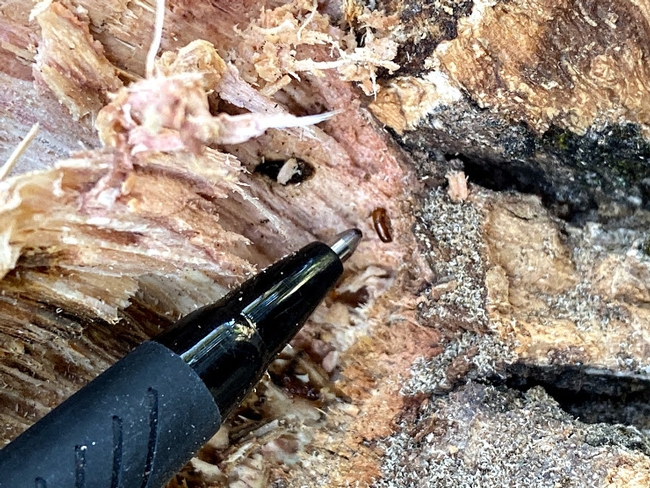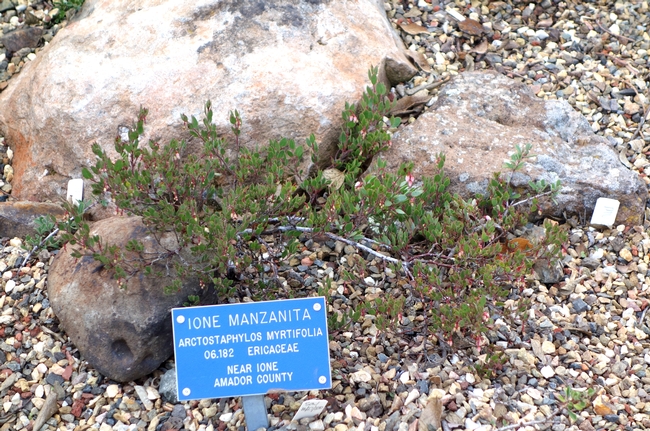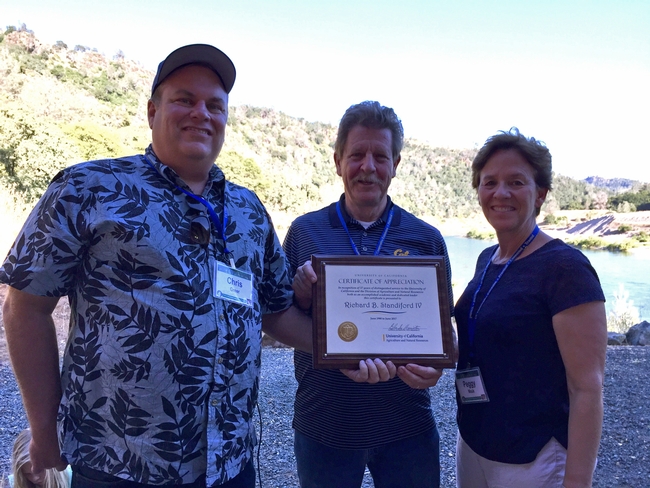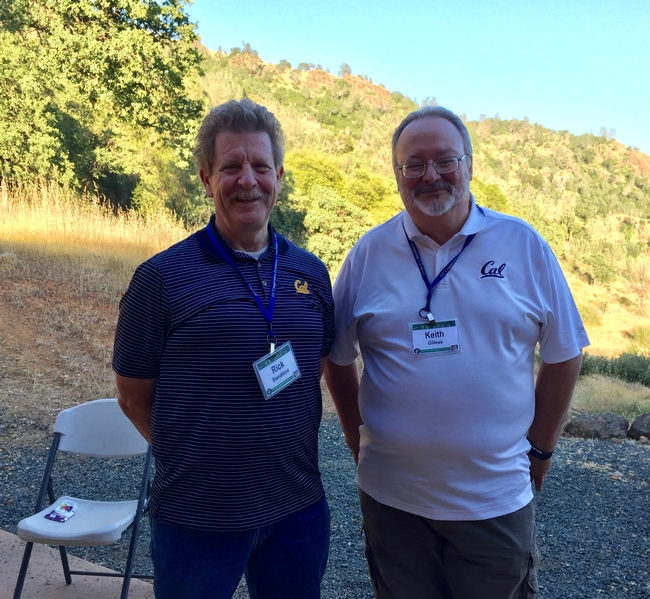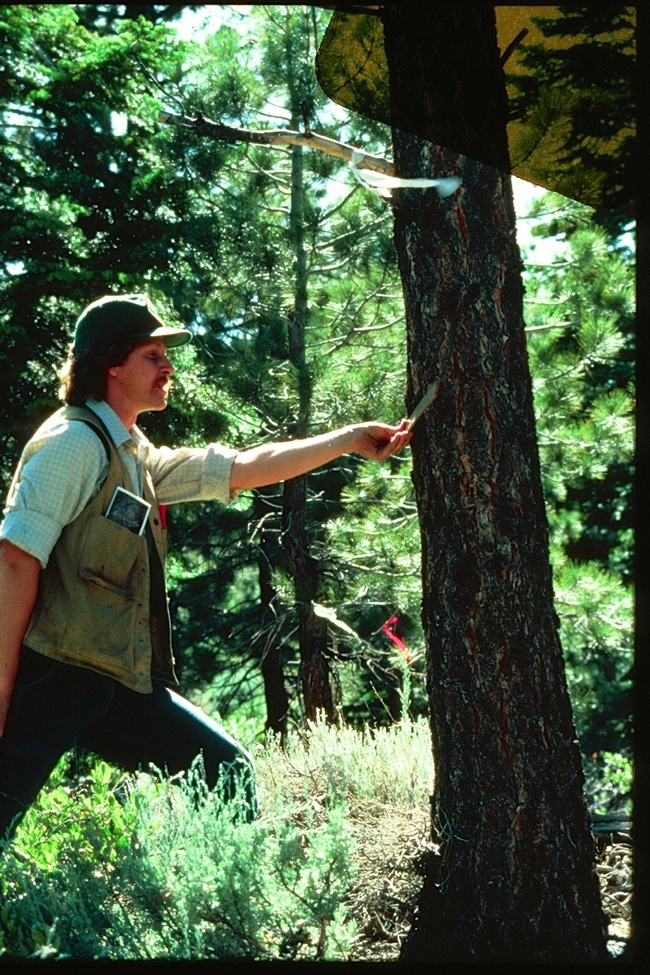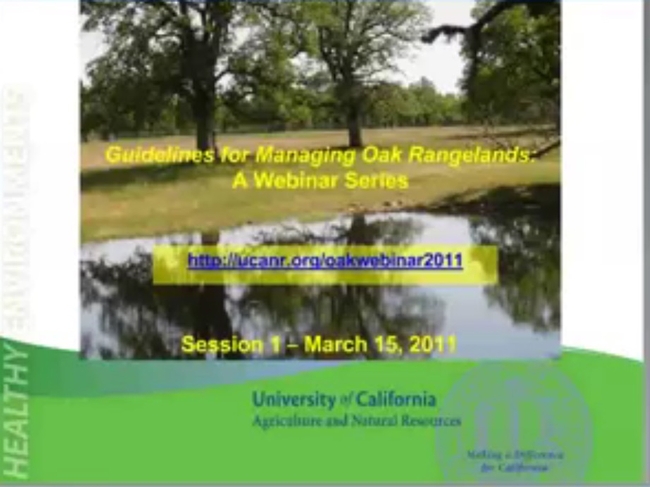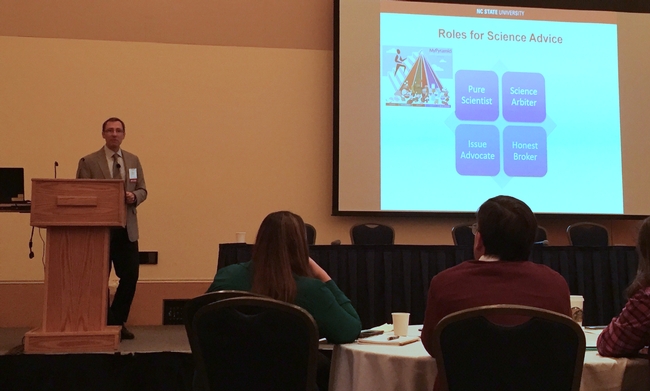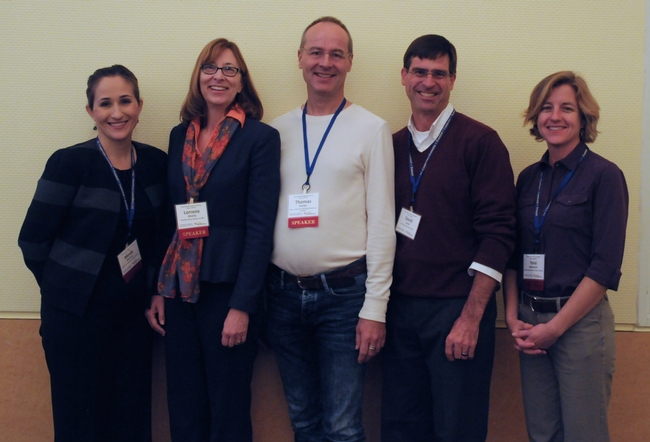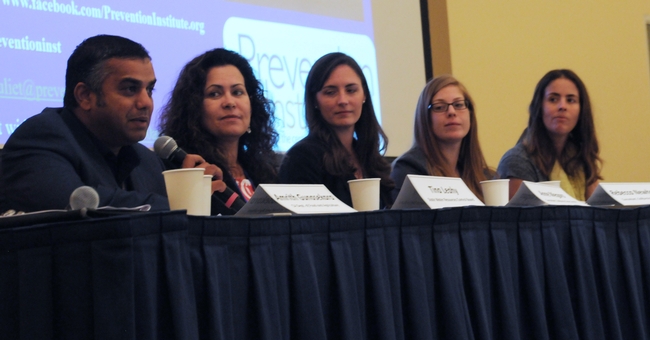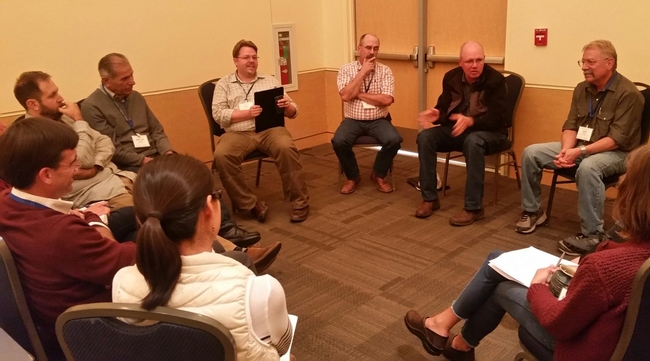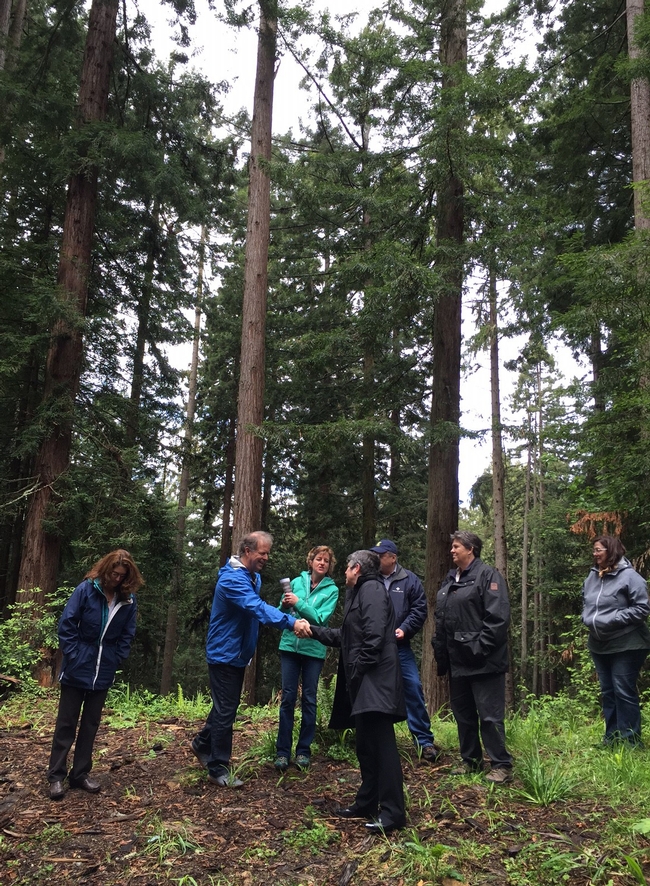Posts Tagged: Yana Valachovic
Names in the News
Solins joins UC ANR as new environmental horticulture advisor
Joanna Solins joined UC ANR on Oct. 3 as a UC Cooperative Extension environmental horticulture advisor for Sacramento, Solano and Yolo counties.
Solins will focus on research and outreach related to urban plants, landscaping and climate change, while building relationships with county and municipal governments, nonprofits, landscape and tree care professionals, nursery growers and utilities, among others. She also will support the UC Master Gardener coordinators in her assigned counties, collaborating to extend knowledge and resources to community members.
“My core goals are to improve the climate suitability and ecological performance of urban landscaping and promote the equitable distribution of benefits from urban plants,” Solins said.
After attaining a bachelor's degree in environmental studies at Vassar College, Solins began her career leading outreach education programs for the New England Aquarium and writing for educational publishers. She also worked in communications at the Coral Reef Alliance in San Francisco before starting graduate school at UC Davis, which culminated in a master's in geography and Ph.D. in ecology.
Solins' research at UC Davis combined field studies and geographic information system analysis to investigate plant communities, tree canopy and soils along urban creeks in the Sacramento area. She also carried out postdoctoral research on green stormwater infrastructure, urban forest composition, and the water demand of urban vegetation across California, and contributed to projects examining residential landscaping and urban heat in Sacramento.
Solins is based in Sacramento and can be reached at jsolins@ucanr.edu or (916) 875-2409.
Mar named UCCE organic materials management advisor
Stephanie Mar joined UC Cooperative Extension on Oct. 3 as the assistant organic materials management advisor serving Los Angeles, Orange and San Diego counties. Mar is responsible for investigating ways to divert organic wastes from landfills to alternative end markets, such as circular food economies, composting and wastewater reclamation.
“To me, waste doesn't have an end life, just a next life,” said Mar. “A lot of people don't know what happens to their waste after the garbage truck comes or they flush a toilet, so a part of my job is to understand what we are wasting and what happens to it.”
Mar attended the University of North Carolina at Chapel Hill where she earned a master's degree in public health focused on environmental science and engineering, and a master's degree in city and regional planning focused on land use and environmental planning. She also has a bachelor's degree in public health from UC Berkeley.
Much of Mar's professional experience, like her time working for the City of Berkeley, is centered on community outreach and policy development, two strengths that she believes will serve her well in this new role.
Previously, Mar worked as a public health analyst for UC San Francisco and as a social research analyst with the North Carolina Department of Health and Human Services too. Both of which strengthened her understanding of policy and program development, implementation, and monitoring and evaluation.
“Research gives us a lot of information, but then there's a need for translation from what we know to what it actually means,” she said. “There are a lot of people doing different things [to manage their waste], so there's a need for coordination and dispersal of information."
Mar's background in policy development is something she'll rely on to operationalize the research being done by herself and her colleagues.
Behavioral change is one of Mar's anticipated challenges in this role. Even if research and policy efforts yield successful results, encouraging the community to adapt can be an uphill battle.
“Sorting trash, for example, is more of a mental burden than a physical one,” she explained. “We know what the research says and what we need to do, it's just about developing the market to make it happen.”
Mar is based out of Irvine at the South Coast Research and Extension Center and can be reached at samar@ucanr.edu.
Dobbin named UCCE water justice policy and planning specialist
Kristin Dobbin has joined UC ANR and the Department of Environmental Science, Policy, and Management at UC Berkeley as a UC Cooperative Extension specialist focused on water justice policy and planning.
Originally from Utah, Dobbin comes to Rausser College from UC Los Angeles' Luskin Center for Innovation, where she was a National Science Foundation postdoctoral fellow. Dobbin pairs her love for rural communities, community natural resource management and environmental justice organizing with a strong belief that research can and should play an important role in advancing policy. She hopes to leverage her new position, the first of its kind for UC, to uplift community water managers and impacted residents as leaders and experts in conversations surrounding water management and access.
“It's a dream and a responsibility to be assuming a role that so perfectly weds research and impact,” Dobbin tweeted about her new UC Cooperative Extension water justice policy and planning specialist role.
Dobbin earned her Ph.D. in ecology with an emphasis in environmental policy and human ecology from UC Davis and B.A. in environmental analysis from Pitzer College in Claremont. Prior to graduate school, she worked for the Community Water Center – a grassroots environmental justice organization that advances community-driven solutions for water justice in the Central Valley.
Dobbin is based at UC Berkeley and can be reached at kbdobbin@berkeley.edu and on Twitter @kbdobbin.
Shive named UCCE forest and fuels management specialist
Kristen Shive has joined UC ANR and the Department of Environmental Science, Policy, and Management at UC Berkeley as a UC Cooperative Extension specialist focused on forest and fuels management.
Bringing more than 20 years of experience in conservation, forest and fire management, and ecology, her work broadly focuses on restoring fire to fire-adapted ecosystems, prioritizing areas for restoration, and understanding shifting fire regimes. Prior to joining UC ANR, Shive led the forest program science team for The Nature Conservancy's California Chapter and was the director of science for Save the Redwoods League. She also has worked for the National Park Service in Alaska, California and Wyoming, most recently as the fire ecologist for Yosemite National Park.
She earned her master's degree in forestry from Northern Arizona University and a Ph.D. in ecosystem science from UC Berkeley.
Shive is based at UC Berkeley and can be reached at kshive@berkeley.edu and (630) 917-5170 and on Twitter @klshive.
Bacon joins NPI as policy analyst
Kassandra Bacon joined the Nutrition Policy Institute on Oct. 12 as a project policy analyst.
Bacon earned her Master's in Public Health with a concentration in public health nutrition and Graduate Certificate in Food Systems at the UC Berkeley School of Public Health and B.S. in nutritional sciences from the University of New Hampshire, Durham.
During her academic journey, she contributed to several research projects pertaining to sustainable food systems, program evaluation, and improvement of public nutrition policy. Additionally, her experience includes program coordination and evaluation, data analysis, and development of communication materials to advance equity-based public health solutions.
At NPI, Bacon will continue to support public health nutrition through policy and program evaluation. She will work on projects related to nutrition and increasing consumption of drinking water and in childcare and universal school meals.
Bacon is based at UC Office of the President in Oakland and can be reached at kabacon@ucanr.edu.
Rodriguez joins 4-H as advisor in Northern California
Matt Rodriguez joined UC Cooperative Extension on Sept. 5 as a 4-H youth development advisor for Nevada, Placer, Sutter and Yuba counties. As a 4-H advisor, Rodriguez implements extension education and applied research programs grounded in positive youth development theory. He also provides expertise to enhance volunteer engagement in 4-H youth development programs.
Rodriguez earned his Ph.D. from the University of Maryland's School of Public Health in the Department of Family Science. His dissertation, “Influence of Latinx Fathers' Behaviors, Cognitions, Affect, and Family Congruence on Youth Energy Balance-Related Health Outcomes,” investigated Latinx father involvement in the context of youth energy balance-related behaviors. During his doctoral training, Rodriguez also supported several USDA-funded research initiatives involving Latinx fathers and youth. His recent publication, "Predictors Associated with Fathers' Successful Completion of the FOCUS Program,” investigated a sample of fathers in Texas who participated in a child welfare parenting intervention.
Rodriguez currently co-chairs the Men in Families focus group at the National Council on Family Relations. He was also recently elected as Section Counselor for the American Public Health Association's Health Informatics Information Technology section.
Prior to his doctoral studies, Rodriguez was a professional web developer for several large nonprofits in the Midwest. Growing up in a multicultural family with ancestry deriving from Puerto Rico, Japan, Nigeria and England, he embraces the importance of cultural diversity and competency in his family science research.
Rodriguez is based in Auburn and can be reached at (530) 889-7391 and mrro@ucanr.edu and on social media @MattR_Rodriguez.
Martinico named human-wildlife interactions advisor
Breanna Martinico joined UC Cooperative Extension as a Human-Wildlife Interactions Advisor on July 5. She will work on issues that involve wildlife as agricultural pests and beneficial species. She will be conducting a needs assessment to learn about priority issues in Napa, Lake and Solano counties.
Martinico is a wildlife biologist and ecologist, specializing in ornithology. Her past research addressed the role of birds on farms as pests and pest control agents. She has worked on projects investigating the important role farmland plays as habitat for California birds. In other work with the USDA Western Sustainable Agriculture Research and Education program, she investigated the implications of agricultural land-use and pest management practices on raptor ecology and conservation.
Martinico is a UC Davis graduate with a B.S. in wildlife fish and conservation biology, MS in avian sciences, and has nearly completed her Ph.D. in ecology.
Martinico is compelled by the co-existence and mutual benefits of humans and wildlife in agroecosystems and is committed to working to find solutions that benefit both people and wildlife. She is excited to be part of UC ANR where she can develop a research and extension program that has the power to increase knowledge and adoption of management practices that promote ecological sustainability and increase farm viability in California.
Martinico is based in Napa and can be reached at bmartinico@ucanr.edu or (707) 253-4141.
Forest Stewardship Education Initiative wins award
UC ANR's Forest Stewardship Education Initiative received the national Family Forest Education Comprehensive Program Award from the National Woodland Owners Association and the National Association of University Forest Resources Programs.
The award is shared by the UC ANR forestry team which includes co-principal investigators: Susie Kocher, UCCE forest and natural resources advisor for the Central Sierra; Mike Jones, forestry advisor for Mendocino, Lake and Sonoma counties; and Kim Ingram, Forest Stewardship Education Initiative academic coordinator.
Other UC ANR forestry team members include Yana Valachovic, UCCE forest advisor for Humboldt and Del Norte counties; Ricky Satomi, forestry and natural resources advisor for Sutter, Yuba, Placer, Nevada and Butte counties; Ryan Tompkins, UCCE forest and natural resources advisor for Plumas, Sierra and Lassen counties; Rob York, UCCE specialist and co-director of Berkeley Forests; Bill Stewart, UCCE specialist emeritus; Rachelle Hedges, Berkeley Forests project and policy analyst; and Ariel Roughton, Berkeley Forests research stations manager.
The initiative – developed in 2019 as a project through input by the Forest Landowner Education and Outreach Working Group of the California Governor's Forest Management Task Force – is focused on educating private forest landowners to better understand, manage and protect their forests by developing a forest management plan, engaging with natural resource professionals, and taking advantage of cost-share opportunities that can help them meet their management goals.
The program was implemented using three-day forest stewardship workshops prior to COVID-19 and an educational construct involving self-study in advance of online sessions with resource educators during the pandemic.
Currently the program involves nine weekly online sessions and one in-person field day. Completion of the workshop series entitles participants to an initial site visit by a resource professional. To date, 335 individuals attended, with 98% indicating improvement in the understanding of forest management planning, 89% planning to consult with a professional, and through May 2022, 49 participants have had site visits from professionals using the program's $800 stipend that supported the visit.
Evaluators felt that the sessions reflected “Excellent submission and programming,” and that it was “Highly complementary that personnel follow-up with participants AFTER the program to determine impacts cited.” Some were also impressed when recognizing the narrative that program managers would like to reach more private landowners about participating in the program using a benefit/barrier assessment.
One evaluator commented, “This is a very high-quality program. It easily rates very high in each of the criteria categories. The nomination package was thorough and it is evident that those involved in the development and delivery of these workshops are knowledgeable and passionate about landowner and professional education. Kudos to California!”
“Our funder CAL FIRE was so pleased with the program that they funded an expansion starting in 2022, which includes additional field days for people not in the workshops, and additional outreach to broad audiences across the state,” Kocher said. “We have funding for two community education specialists and a communications person, which are under recruitment.”
The award was presented on Sept. 22 at the 2022 Society of American Foresters national convention in Baltimore, Maryland.
Roche and multi-state team win NIFA Partnership Award
Leslie Roche, UCCE rangeland management specialist, received on Oct. 6 the USDA National Institute of Food and Agriculture Partnership Award for Multi-State Efforts on behalf of the National Connections Team for Forest and Rangeland Resources.
The certificate reads, “NIFA recognizes the National Connections Team for Forest and Rangeland Resources, based at the University of Hawaii-Manoa, for developing a webinar series around Renewable Resources and Extension Act critical issues. The team's goal for the webinar series was to strengthen RREA programming by increasing renewable resource Extension and outreach professionals' capacity to provide scientific and technologically relevant content. It showcased innovative programming developed by forest and range professionals from Land-grant universities across the nation. Evaluations showed the series had both national and global appeal. Additionally, the webinar series were influential with participants indicating that they had learned ways to enhance their own programming.”
The multi-state team was led by Mark Thorne (University of Hawaii-Manoa) and Barb Hutchinson (Rangelands Partnership/University of Arizona) and includes Kris Tiles (University of Wisconsin), Retta Bruegger (Colorado State University), Adam Downing (Virginia Tech), Sheila Merrigan (Rangelands Partnership/University of Arizona), Martha Monroe (University of Florida), Dave Bogner (University of Arizona), Elise Gornish ( University of Arizona), and Roche.
The web-based conference series can be viewed at https://globalrangelands.org/rreasp/webinars.
4-H receives national recognition
At the National Association of Extension 4-H Youth Development Professionals annual conference, UCANR 4-H was recognized. Fe Moncloa, 4-H advisor for Santa Clara County; Martin Smith, UCCE specialist; Charles Go, former 4-H advisor for Contra Costa County; and Lynn Schmitt-McQuitty, statewide 4-H Youth Development director and interim director of County Cooperative Extension, received awards for 25 years of service to the organization. JoLynn Miller, 4-H youth development advisor, received the distinguished service award for 7 to 15 years of service to NAE4-HYDP. Stephanie Barrett, 4-H community education supervisor for Southern California, received an achievement-is-service award for serving 3 to 7 years.
Hundreds sign up for online oak woodland workshop
California oak woodlands are highly prized ecoregions where stately trees, many of them hundreds of years old, are cornerstones of a habitat for wildlife and native plants. Sadly, some of these ecosystems are seriously threatened by exotic pests and diseases, encroachment by less desirable vegetation, and wildfire.
Each year, UC Cooperative Extension hosts workshops to share scientific developments aimed at conserving these important habitats – and the economic value of ranching – on oak woodlands, which are found on the lower elevation slopes of the Sierra Nevada, the Coast Range and other foothill areas of California.
Typically, the workshops are held in person and draw moderate-sized audiences for presentations, questions and answers, and field trips. Because of the COVID-19 pandemic, this year's workshop was offered online in April with pre-recorded presentations available for viewing at the participants' convenience and a live question-and-answer session on Zoom.
The retooled event garnered 500 registrants, over 300 views of the YouTube videos and 140 participants in the live Q&A session. The presentations and Q&A session are still available online for future viewing as well.
“People from all walks of life participated, including those with professional and personal interest in oak woodlands,” said Yana Valachovic, UCCE forest advisor in Humboldt and Del Norte counties and a conference organizer.
Presentations at the 2020 conference included the following topics:
Encroachment by Douglas-fir
In Northern California, the biodiversity of oak woodlands is being threatened by Douglas-fir encroachment. The oaks' shade helps the young conifers get established with protection from harsh sun. In time, the fast-growing Douglas-fir trees pierce the oak canopies and begin to crowd out the areas' native understories, which are important for the diversity of birds, mammals and reptiles attracted to oaks.
As the Douglas-fir continue to grow and multiply, they threaten the very lives of the oak trees and the unique ecosystem they dominate.
To better understand the Douglas-fir encroachment, Valachovic established 10 research sites in Humboldt and Mendocino counties to gather information about the fate and the age of oaks. She and her research partners determined the ages of the oaks and firs, and counted the seedlings, saplings, snags and understory vegetation.
“With this research, we were able to demonstrate that even though the oak trees can be smaller in diameter they are much older than the Douglas-fir trees,” Valachovic said. “The encroachment process is happening quickly, and the oaks are falling out of the system.”
The shift appears to have been initiated in the mid-19th and early-20th centuries, coinciding with the Gold Rush and wildfire suppression.
With the data confirming Douglas-fir encroachment, Valachovic turned her attention to oak woodland restoration. At 14 sites in Humboldt and Trinity counties, her team studied the effects of Douglas-fir removal.
“Grasses and forbs under the oaks reestablished. Diameter growth on the oaks increased,” she said.
These research findings contributed directly to changes in policy that had previously limited land owners' ability to remove and sell conifers encroaching on oak woodland. The research also helped create new funding opportunities to support oak woodland restoration and conservation in Northern California.
Case study of oak woodland wildfire recovery
In July 2018, about two-thirds of the 5,289-acre UC Hopland Research and Extension Center was burned by the River Fire.
The transformation of the land, which had likely been without a large wildland fire for at least 100 years, was intense and stressful, said UC Cooperative Extension forest advisor Michael Jones. However, it also provided a unique opportunity for researchers to compare the impact of wildfire on the resiliency of vegetation on grazed and ungrazed oak woodland.
Jones established 35 one-fifth acre research plots at the research center and collected data two months following the fire and one year later. The research will continue in the future to better understand long-term impacts, but Jones was able to share revealing early results at the workshop.
Right after the fire, in severely burned areas areas, the future of the oaks looked ominous. Jones predicted 40% tree mortality.
“The oaks were exposed to persistent, intense heat. They were cooked,” he said. “But two months after the fire, we were already seeing basal sprouts. This was an amazing response by the trees. Oaks are pretty damn tough.”
A year after the fire, surveys showed that tree mortality in the burned areas was 25%, much less than Jones' early predictions. While some management for specific situations in severely burned areas may be necessary – such as removal of hazard trees, reducing fuels in defensible spaces or removal to control invasive species – the results of this work show the trees recover naturally.
“Esthetically, I know these systems aren't as pleasing as they were before, but ecologically, they are healthy and recovering,” he said. “In 100 years, it will look just as good as before the fire.”
Fire impacts in woodland areas previously grazed and not grazed
The fire on the research station also permitted Jones to compare the fire's differing impact on non-grazed and grazed oak woodland. At first, the grazed areas looked almost unscathed with minimal flame scorching on the bark, while an area where the pasture hadn't been grazed for 25 years had evidence of much higher severity fire.
“Grazing is a phenomenal way to help manage fuels,” Jones said. However, the grazed areas displayed ecological shortcomings a year later.
“In grazed pastures, the large mature trees were still alive, but there was no oak regeneration (basal sprouting or seedlings),” Jones said. “In the ungrazed area, a lot of biomass had been killed, but there's nearly 100% resprout of oak trees and we have an impressive amount of oak seedling recruitment.”
Jones said he isn't discouraging grazing.
“But it is important to protect sites from grazing, and especially wildlife browse, when a landowner or land managers' objectives are to regenerate or conserve oak woodlands,” Jones said.
New ambrosia beetle another threat to California oaks
Akif Eskalen, UC Cooperative Extension specialist in the Department of Plant Pathology at UC Davis, has identified a new insect-fungus team that causes oak borer wilt in Northern California Valley and Blue Oaks. It is an ambrosia beetle, commonly known as Mediterranean Oak Borer, which carries several fungi in its mouth. The beetle bores into the tree and introduces fungi to grow for food. The fungi spreads and disturbs the transportation of water and nutrients, causing wilt in the tree.
The oozing and staining lesions on the bark are similar to other oak fungal diseases, such as Sudden Oak Death. The beetle – native of Mediterranean basin countries in Africa, Asia and Europe – cannot fly far, so most likely is transported for long distances on infested firewood.
During the workshop, Eskalen suggested not moving firewood, removing heavily infested trees and chipping infested wood into 1-inch particles to reduce the spread of the ambrosia beetle and its fungal partner. He asked viewers to report any suspected oak tree infestations to the local agricultural commissioner, CDFA Diagnostic Laboratories, UC Cooperative Extension advisors or CALFIRE. Chemical options for sparing oaks from the ambrosia beetles' devastation are under investigation.
Threats to oaks and other native plants from root rotting Phytophthora
Restoration plantings have inadvertently introduced plant pathogens to native oak woodland ecosystems in California, said Ted Swiecki of Phytosphere Research, an organization that provides consulting services related to natural resource management, horticulture, urban forestry, and agriculture. The group of pathogens causing the damage are largely from the Phytophthora genus, first described in the 1860s. The name translates from Greek to “plant destroyer.”
Swiecki has observed when Phytophthora infested plants and soils are introduced to native habitats, the pathogens can attack various native plants, including toyon, madrone, manzanita and full-grown oaks. Once established, the pathogen can spread along drainages, by moving soil from one area to another and by hitchhiking on equipment, tires and hiking boots.
The pathogen can easily be overlooked at nurseries, which, by their nature, have conditions that favor Phytophthora development. Plants at nurseries are well watered, have high root density and are often placed on the ground where they can pick up pathogens.
He said the best approach to tackling Phytophthora is not using nursery stock for restoration or beautification of natural oak woodland. Direct seeding, using natural regeneration, or onsite propagation are safer ways to enhance vegetation in oak woodland.
“It's easier to prevent Phytophthora from being introduced in the first place and much cheaper and more effective than trying to eradicate it later,” Siewcki said.
Standiford retires from 37-year UC ANR career
Wrapping up a remarkable 37-year career with UC ANR, Richard B. Standiford IV, UC Cooperative Extension forest management specialist at UC Berkeley, will retire June 30.
In addition to being a highly regarded forestry expert, Standiford served as UC ANR's associate vice president from 2005 to 2009, and provided stability for the division as acting vice president during the 11-month transition from Reg Gomes stepping down to retire until Daniel Dooley succeeded him as vice president in 2008.
“There are a select few individuals who both excel at research, teaching, service and outreach and can lead and motivate others to try to do the same. Rick belongs to this rarest subspecies of academic,” said Keith Gilless, dean of the College of Natural Resources at UC Berkeley, who has worked with Standiford for 35 years.
In 1980, after working two years as a research and extension forester at Purdue University, Standiford joined UC Cooperative Extension at UC Berkeley. The New Jersey native developed a research and extension program focused on sound management of California's forests, rangelands and other natural resources.
Standiford “personifies all that is best about Cooperative Extension,” said Maggi Kelly, director of the UC ANR Statewide Informatics and Geographic Information Systems Program, professor and Cooperative Extension specialist in the Department of Environmental Sciences, Policy & Management at UC Berkeley.
His legacy in Cooperative Extension continued to grow as associate vice president of ANR, says Peggy Mauk, former director for Central Coast and South Region.
“Rick empowered people, empowered regional directors and county directors to implement programs for the betterment of California,” Mauk said. “Rick had the ability to bridge the gap between administrative concepts and regional (county) implementation. He wanted to know how higher level decisions would impact ANR's county-based personnel and programs and then adjust for those impacts. Above all, Rick valued people and positions, and supported the ANR mission.”
He also has provided leadership for county Cooperative Extension advisors developing programs in forestry and conservation of oak woodlands.
“Rick has a tremendous ability to pull people together,” said Yana Valachovic, UCCE director and forest advisor for Humboldt and Del Norte counties, noting his leadership in getting people to work together to contain sudden oak death disease. “It takes passion, vision and an ability to communicate effectively.”
While tackling the emerging forest disease, Standiford also devoted time to mentoring young scientists.
“Early in 2000, Rick bounced into my office with the news that he had found emergency funds to study the disease, and had assembled a team of pathologists, ecologists, arborists, homeowners and forest managers to attack the problem,” said Kelly, a remote-sensing expert. “Rick asked if I would be able to use the money to fly to Marin County and develop critical baseline maps of the nascent disease. I was, and I did, and that generosity and foresight launched my applied research and extension program at Berkeley.”
“The disease was subsequently named Sudden Oak Death, and in 2015 ANR was been given a nationwide award in extension for its timely, quality, impactful multidisciplinary approach to the disease,” Kelly said, “and it all started with Rick.”
Standiford said working with people was the part of his career he enjoyed most. He recalled driving with UCCE colleagues to Mariposa County to deliver a workshop on managing oaks.
“The sun was setting, it's pretty dark, pretty desolate and we're wondering, ‘Is anybody going to be at the workshop?'” Standiford said. “At the grange hall in Catheys Valley, there's a ton of pickup trucks and cars. Inside, everybody is excited that the university has shown up to help figure out how to manage their trees. That's what my job has been about. It was always a lot of fun.”
An early adopter of technology, Standiford has used webinars to teach oak woodland management from a distance. While acknowledging the convenience of virtual meetings, he said, “I hope we don't lose sight of the value of personal contact.”
From 1985 to 1987, Standiford served as ANR program director for natural resources, leading efforts in forestry, wood products, wildlife and range management.
From 1988 to 1999, Standiford led collaboration among UC, the California Department of Forestry and Fire Protection, and the California Department of Fish and Game for the ANR statewide Integrated Hardwood Range Management Program, which was established in 1986 by the California Legislature to address poor oak regeneration and ongoing woodland losses. The program continued for 23 years until its budget was cut in 2009.
At UC Berkeley, he coordinated all Cooperative Extension activities in the Department of Forestry and Resource Management from 1989 to 1993, served as associate dean for forestry and director of the Center for Forestry from 1998 to 2002 in the College of Natural Resources, and oversaw the College's capital projects program, space planning and research infrastructure as associate dean for forestry and capital projects from 2002 to 2004.
In retirement, Standiford plans to teach at the UC forestry camp and remain active with the Society of American Foresters. He also plans to travel with his wife, Judy, and spend time coaching and camping with his five grandchildren
“I have been blessed with the most wonderful job in the world,” Standiford said. “The best part was the honor of working with such wonderful people on campus, in the counties, and the wide group of landowners and managers who taught me so much.”
UC Research to Policy Conference puts science into action
“We focused on fostering a good dialogue and facilitating co-learning among attendees,” said event co-chair Leslie Roche, assistant UC Cooperative Extension specialist in rangeland management. “We hosted university faculty, statewide CE specialists and academics, and county-based CE advisors—as well as local policymakers and leaders from non-governmental organizations and statewide programs.”
UC researchers who have successfully engaged in the public policy arena provided numerous models of linking research and policy. There were five key take-aways for scientists:
- Honest broker role – Present policymakers with various policy options, based on sound research. Have a clear understanding of the science behind your messaging. Use qualitative data to tell the story of the hard quantitative data.
- Active engagement – Be part of informational and oversight hearings. Empower communities to take action and foster community engagement.
- Build coalitions – Collaboration is imperative. Develop unexpected allies and foster long-term relationships, realizing it may take some time to bear fruit.
- Disseminate information – Share your data in user-friendly formats. Target local community, Legislature and state agencies to inform policies. Get your science into trainings and continuing education programs. Leverage your coalition to expand the circulation of your research results.
- Target messages – Develop a strong, concise message to deliver your research. Use an emotional connection – “Old-growth oak woodlands” versus “oak woodland.”
Throughout the conference, speakers highlighted the multiple levels of engagement for researchers in the policy arena, with different roles matching different needs – some take a center stage, while others play imperative behind-the-scenes roles.
Keynote speaker Jason Delborne, associate professor of science, policy and society at North Carolina State University, encouraged engaging the public. “Science is a social process,” he said, noting that community and public engagement is often key to successfully applying research to policy. Delborne also touched on the tension between expertise and democracy, commenting that we can't always resolve it and often we have to learn to live with this tension.
A diverse set of researchers shared their perspectives from experiences in engaging in policy. The panel included Thomas Harter, Robert M. Hagan Endowed Chair in Water Management and Policy and UCCE specialist in the Department of Land, Air, and Water Resources at UC Davis; Lorrene Ritchie, director of the UC ANR Nutrition Policy Institute; Mindy Romero, founder and director of California Civic Engagement Project at UC Davis Center for Regional Change; and Yana Valachovic, UCCE forest advisor and county director in Humboldt and Del Norte counties. They discussed the importance of building strong science-based programs, actively engaging local communities and building coalitions of support.
Guests from both government and non-government organizations who use research to shape policy shared their perspectives on translating science to decision-making.
“Science is the foundation for developing programs,” said Amrith Gunasekara, science advisor for the California Department of Food and Agriculture.
Tina Cannon Leahy, attorney with the State Water Resources Control Board, noted that policymakers and decision-makers are often looking for a clear, “black-and-white” answer, while for scientists, there is “no answer,” but rather information.
Anne Megaro, consultant to the California Senate Committee on Agriculture, and Rebecca Newhouse, consultant to the California Senate Environmental Quality Committee, both emphasized the importance of making sure science is accessible and digestible.
Juliet Sims of the Prevention Institute explained how her organization uses both published scholarly literature and community stories to effectively inform its advocacy platform.
Keynote speaker Rachel Morello-Frosch, associate professor in the Department of Environmental Science, Policy and Management at UC Berkeley, introduced the concept of moving from “translational research” to “transformational research,” a shift that requires deep community engagement in meaningful ways to effect policy change.
In the afternoon, four breakout sessions were offered: “Policy structures and opportunities for engagement” with Robert Waste, “Relational approaches to science communication and engagement” with Faith Kearns, “Putting it into practice–UC ANR case studies” with Dave Campbell, Clare Gupta and Lucas Frerichs, and “Navigating policy engagement: Education vs advocacy,” with Adrian Lopez and Kit Batten. These training modules helped participants build technical skills and analytical frameworks for successful policy engagement.
The Research to Policy Conference was a forum to exchange ideas and share perspectives, continuing to bridge the gap between science and policy communities. It challenged attendees to be open to new ways of thinking, shared innovative outreach methods and showcased how research can have an impact in the policy arena.
“The event brought cross-fertilization and co-learning between disciplines – nutrition, forest management, water quality – and there were common themes that resonated for all participants,” said event co-chair Gupta, assistant UCCE specialist in public policy and translational research.
VP Glenda Humiston wrapped up the policy conference by saying, "Good science is vital for good policy. It's great to see UC folks enhancing these skills to bring science together with policy."
For more information on applying research to policy, contact Frerichs, UC ANR government and community relations manager, at (530) 750-1218 or lfrerichs@ucanr.edu, or Research to Policy Program Team contacts Gupta at cgupta@ucdavis.edu and Roche at lmroche@ucdavis.edu.
Napolitano visits UCCE in Humboldt County
The university opened its first Cooperative Extension office in Eureka in 1913, but April 27 marked the first official visit to Humboldt County by a UC president.
“I hope to show the president how local residents benefit from UC Cooperative Extension and to give President Napolitano and Vice President Humiston ideas on how the university may get more involved in solving local challenges,” said Yana Valachovic, UC Cooperative Extension director and forest advisor for Humboldt and Del Norte counties, as the tour she organized got underway.
Valachovic introduced Napolitano and Humiston to community members at Potawot Health Village, where they learned about UC's nutrition education projects. Next, they boarded a boat with a shellfish producer and members of California Sea Grant, who briefed them on climate change research in Humboldt Bay.
At City of Arcata Community Forest, where UC has been conducting forest research since the 1920s, the City of Arcata environmental services director discussed how the city works with UC to manage its 2,300 acres of redwoods for timber, wildlife, water quality and to sequester carbon while providing recreational areas for city residents.
The president and Humiston ended the tour by reciting the 4-H pledge and listening to 4-H members and volunteers describe their projects.
To read more about the tour, visit http://ucanr.edu/?blogpost=21065&blogasset=52096.

